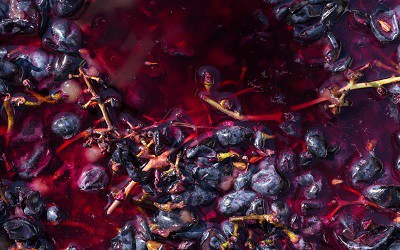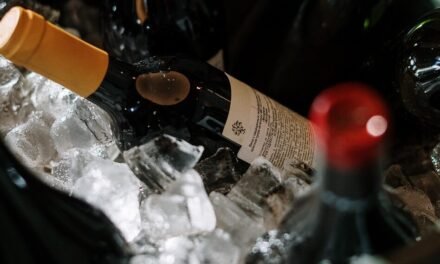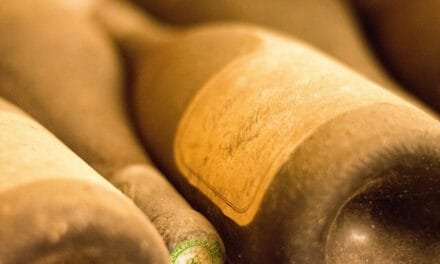Tannins are natural compounds that occur in grape skins, seeds, and stems. They affect the color, balance, and structure of a wine. And they determine its age-worthiness. In the mouth, tannins create a drying, puckering sensation, and a bitter taste.
To make high-quality wine, vintners have to adjust the level of tannins in their wine carefully. In this article, we will discuss how they do that, what tannins do in wine, and which wines are high (or low) in tannins.
WHAT ARE TANNINS CHEMICALLY AND WHAT DO THEY DO?
Scientifically speaking, tannins are molecules that belong to the group of polyphenols. They consist of oxygen, hydrogen, and carbon atoms.
Tannins occur naturally in many plants, including grapes, pomegranates, almonds, walnuts, and red beans. But they also exist in tea, coffee, and tree barks. They function as a natural line of defense in two ways:
- First, they help keep the plant healthy by protecting it against germs.
- Second, their flavors reduce the appetite of herbivorous animals and keep them from consuming the plant.
HOW ARE TANNINS ADDED TO WINE?
Tannins in wine come from two different sources: naturally from the grapes or from oak wood during the winemaking process. Vintners have several options to impact the final level, though.
- Tannins occur naturally in the skins, seeds, and stems of grapes. The amount varies based on the grape variety, though. So by selecting a varietal that is higher or lower in natural tannins, vintners can determine the levels in the resulting wines.
- After the harvest, winemakers crush the grapes and transfer them to a fermentation container. Typically this container is either a wooden cask or a steel tank. During the fermentation, the wine must absorbs the tannins from the grape solids. Logically, extending fermentation time results in higher levels of tannins in wine; vice versa, less time leads to lower levels.

Red Wine Grapes Fermenting with Solids
- In some cases, winemakers want to fasten this process. They do so by performing a technique called “maceration“. They expose the wine to heat and oxygen in order to cook it. Among other results, this process allows more tannins to get into the wine.
- Many vintners blend different wines from different varietals to create a well-balanced wine. By adding wines with higher or lower tannin levels to get to the optimal level.
- Finally, it’s possible to alter tannin levels during the aging process. Many vintners store their wines in oak barrels to give them the chance to age and develop more complex aromas. When the wine gets in touch with the wood, it slowly absorbs its tannins. As oak barrels are costly, some winemakers prefer an alternative method to achieve the same goal: They add oak planks or chips to the most.
In summary, winemakers can impact the level of tannins in wine by choosing the right grape and the proper production process.
HOW DO TANNINS AFFECT THE CHARACTERISTICS OF WINE?
Winemakers have numerous reasons to manipulate the level of tannins. Among them are the desire to change the wine’s color, its quality, and its age-worthiness.
How Tannins Affect the Color Of Wine
Tannins are the major contributor to wine color. When the crushed grapes ferment, they get into the wine must and change its color. The longer they are in contact with the wine, the deeper will its color become. That means that you can estimate the tannin level by investigating wine color: A pale reddish color is an indicator of a low-tannin wine. In contrast, a dark purple color is a sign of a high-tannin wine.
Vintners typically separate the solids of white grapes from the wine must immediately after crushing them. That means that tannins have no chance to color the wine. Thus, wine from white grapes stays white (or yellowish if you will). There is an exception, though: orange wine. Orange wine is made from white grapes as well, but it ferments together with the grapes’ solid parts. That results in more intense colors, typically in the orange or light-brown spectrum.
How Tannins Affect Wine Quality
The structure of a wine is a major quality factor. It refers to the interplay of different characteristics: the different aromas, the acidity, and the tannins. A proper level of tannins contributes to a wine’s quality, given it’s in balance with the wine’s acidity, aromas, and mouthfeel.
How Tannins Affect the Aging Ability of Wine
As mentioned before, tannins are a defense mechanism for grapes. And when transferred into the wine, they also function as a preservative. That means that a high-tannin wine will keep significantly longer than a low-tannin wine. Logically, they also have a bigger chance to age and get better without the risk of spoilage.
During the aging process, the tannins themselves change too. They become softer and more subtle. The astringent, mouth-drying experience gets less distinct. Typically, wine lovers describe wines that provide this improved experience as “smooth”.
Aged wines with complex aromas and smooth tannins are the most desired and often the most expensive. In contrast, young wines with aggressive tannins tend to create an overwhelmingly astringent and rather unpleasant experience.
HOW DO TANNINS TASTE?
Tannins in wine create a bitter taste that you can experience on the back of your tongue. The higher the level is, the more distinct this bitterness will be.
Even more important is the sensation they create. A wine that is high in tannins dries the mouth. It creates an astringent feeling that makes you want to grab a glass of water. You might say that it feels like your gums would stick to your cheeks. Wine experts refer to a wine that provides this experience as “tannic”.
By the way, if you want to test a very straight tannic experience, try this: Brew a cup of black tea. Let it steep longer than it should so that it becomes really strong. Now take a sip. The initial sensation when drinking this tea is almost pure tannin.
WHICH WINES ARE HIGH IN TANNINS?
The most tannic wines are produced from red varietals. Among them are:
- Cabernet Sauvignon is a varietal that vintners grow all around the world. No matter where they do it, the resulting wines are always very tannic. Some Bordeaux wines (that typically are blends of Cabernet Sauvignon and Merlot) are almost undrinkable when young. That’s true in particular for wines with Cabernet Sauvignon as the dominant grape. But after a long aging phase, they become softer and very well-balanced. Besides, wines from the Napa Valley tend to contain a high level of tannin.
- Sangiovese grapes originate from Italy. But vintners in the United States, Argentina, Corsica, and other countries cultivate it too. Sangiovese grapes are the basis for numerous Italian blends, including Chianti, Brunello, Tignanello, and also Super Tuscans. Most of them are high in tannins, and especially Brunello wines are very age-worthy.
- Syrah (or Shiraz as Australians call it) is a versatile varietal that can produce many different styles of wine. Many of them are on the tannic side. In particular, wines from the new world (Australia, California) tend to be high in tannins. But the same is true for Syrah that comes from the Northern Rhone region in France.
- Another Italian varietal that produces high-tannin wines is Nebbiolo. It’s the dominant grape in the region of Piedmont. Winemakers use it to make high-quality wines with great aging abilities. The most popular examples are Barbaresco and Barolo.
- Tempranillo grapes are tannic as well. They originate from Spain. Vintners grow them in the regions of Navarra and Rioja in Northern Spain. In some cases, they take measures to add even more tannins to their wines. Rioja Reserva, for instance, ages for two years in oak barrels before bottling. Besides Spain, you can find Tempranillo wines from Portugal and New World regions like California, Texas, Mexico, and Argentina.
- Tannat comes from a region in the Southwest of France, close to the Spanish border. In the last years, many winemakers in the new world started growing it too. You can find it in Uruguay, Argentina, Brazil, and the United States. While wines from Latin America are rather soft and approachable, Tannat wines from France typically are very tannic.
- Other tannic red wines are Argentinian Malbec, French Mourvèdre, and Italian Montepulciano.

Bottle of Rioja Reserva
WHICH WINES ARE LOW IN TANNINS?
Most white wines contain only little tannin that is barely detectable when drinking them. But you can also find red wines that contain low levels of tannin:
- Pinot Noir wines belong to the most famous wines in the world. They are light and approachable, and their low tannin levels are one reason for that. Pinot Noir is widespread in Central France, where it’s the only component of red Burgundy wines. Besides, winemakers in Germany, Switzerland, Austria, the United States, Canada, and Australia grow it.
- Barbera is an Italian varietal. Just like Nebbiolo, it originates from the Piedmont region. But nowadays it is grown all over the country, and it also made its way to California and other New World wine regions. Barbera wines like Barbera d’Asti are low in tannins, but high in acidity, making them a great match for rich dishes.
- Frappato comes from the Italian island of Sicily. It’s an important ingredient in fruity Cerasuolo di Vittoria blends. You can also find pure Frappato wines of excellent quality.
- Gamay is popular in Beaujolais, a French region adjacent to Burgundy. Gamay wines such as Moulin à Vent or Morgon taste similar to Pinot Noir. Actually, there is a tradition of blending Pinot Noir and Gamay in Switzerland, where vintners cultivate these grapes as well.
- Other low-tannin varietals are Schiava (also called Vernatsch), Dolcetto, and Etna Rosso. All of them are from Italy.
FINAL WORDS
Tannins are an essential component of wine and contribute significantly to the drinking experience. With the information in this article, you are not only able to understand their effect on wine. You are also capable of finding new wines that match your personal preferences in terms of astringency.






